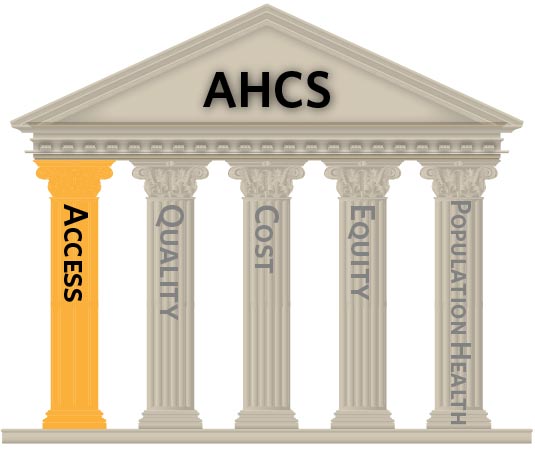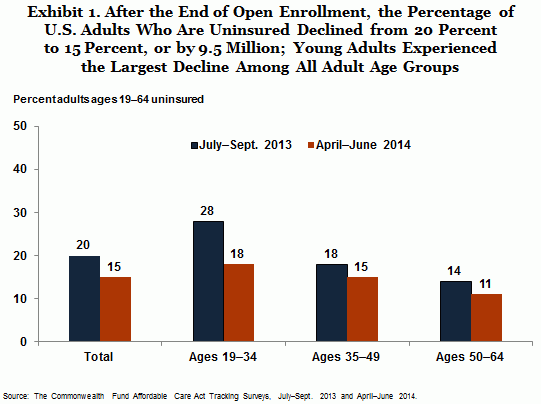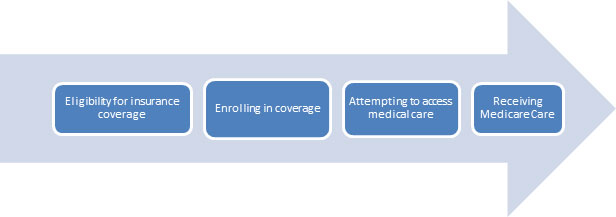Access

Access, Quality, Cost, Equity, and Population Health are the five pillars of this course. We will introduce these concepts today with an emphasis on access.
What is Access?Access in health care refers to the ability of individuals to obtain needed services. |
Coverage
- Health insurance does not guarantee access, but it facilitates entry to health care services.
- In 2012 there were about 47 million non-elderly people without insurance. Why do we say non-elderly? Because Medicare coverage of the population 65 years and older provides a high level of coverage not seen in other age groups. It is important to remember this when thinking about insurance coverage and the uninsured.
- Rates of uninsurance are a moving target, especially with the January 2014 implementation of the ACA individual mandate, Medicaid expansion (in some states) and opening of the Exchanges for individual plans. See below.

The Affordable Care Act (ACA) includes elements of insurance coverage through individual mandates, employer mandates (postponed until 2015) , health insurance exchanges, subsidies for low-income Americans and Medicaid expansion (only in some states) for those in poverty are intended to increase access.
We will return to the topic of Medicaid expansion in the states.

Services
- Ideally access would start with continuity of care from a primary care provider (PCP).
- It is less than ideal when the source of non-emergency care is in the emergency department.
- We will cover many of the other health care providers and care settings as the semester continues.
Timeliness
- Timeliness encompasses waiting time at point-of-care delivery, and lag time between the decision to access a service and the actual receipt of that service.
- Timeliness is also an important aspect of quality.
Workforce
- The shortage of PCPs in the US threatens access, quality and cost.
- Increased use of mid-level practitioners (PAs, NPs) is seen as a potential solution.
- Innovating service models such as telemedicine and team models for primary care may also expand the reach of our existing workforce.
How do we evaluate access?
Measures of access to care may be individual or population based. These include the following:
- Identification of a usual source of care
- Report of going without care due to cost
- Receipt of preventive care (immunizations, colonoscopy)Insurance coverage
- Dental visit within one year
- Wait time to next appointment
- Preventable hospitalizations
- Time or stage at diagnosis for cancer
- Excess deaths (those thought to be preventable through medical care)
The data for several of these measures came from the perspective of patients. When examining access from utilization remember that you are only capturing those who were able to get care. Think about the measure for 'percent of patients with lower back pain receiving an MRI.' If this is based on a review of records for lower back pain patients you only capture those people who chose to or were able to get services in the first place. This measures the rate of MRI use for back pain in a clinical setting, not in the population.
The Uninsured
Throughout the semester we will use materials from the Kaiser Family Foundation (KFF) and the associated sites Kaiser Health News for current events, and KaiserEDU for health policy information.
Note: the Kaiser Family Foundation is a non-for profit foundation focusing on health policy, health journalism, and communication. There is no relationship with Kaiser Permanente or Kaiser Industries.
As we finish up on access please check to see how much you know about the uninsured in the U.S using the Uninsured Quiz from KFF. This is a tool for self-assessment and does not factor into your grade. Resist the urge to look up the answers! At the end of the quiz you will be able to view your responses, the correct answers with feedback, and links for further information.
 |
The large number of uninsured people in the United States has been at the forefront of health policy discussion for decades, and in recent years has received increased attention with the passage of the health reform law in 2010. How much do you know about the uninsured population and the consequences of not having coverage? Take the quiz below to find out. |


